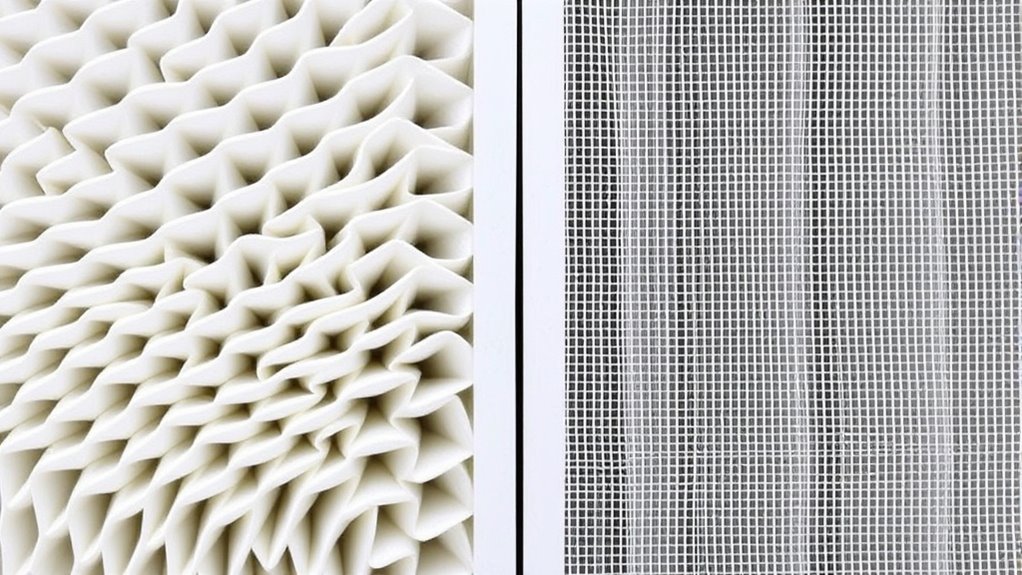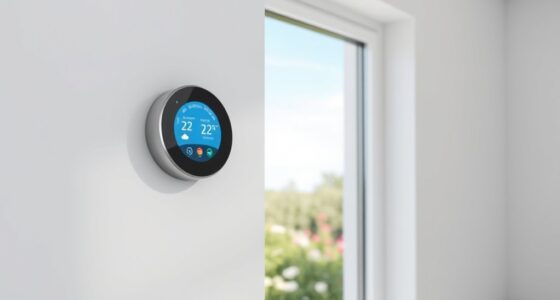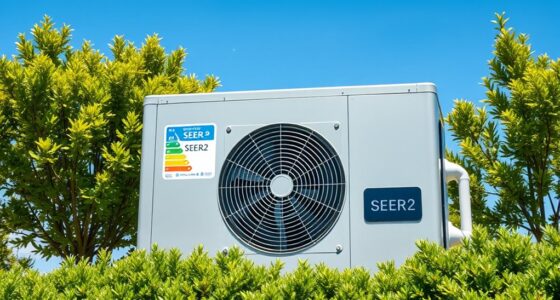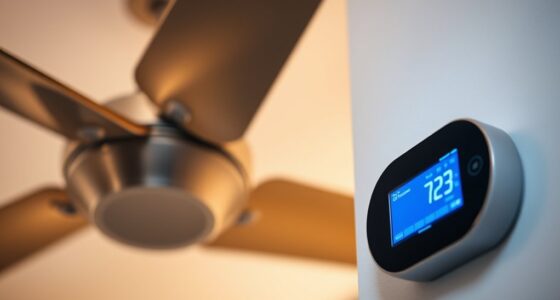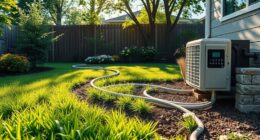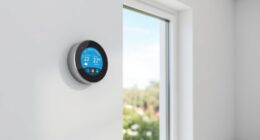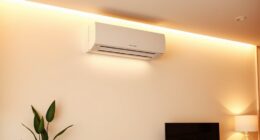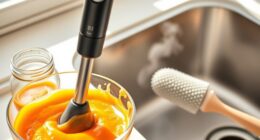If you want better airflow and higher filtration for allergens and dust, pleated filters are your best choice, especially if your system can handle higher MERV ratings. They trap smaller particles and improve indoor air quality but tend to cost more and need regular replacement. Fiberglass filters are cheaper and last about the same time but are less effective at filtering small particles. Choosing the right filter involves balancing your needs—learn more about which option fits your system best.
Key Takeaways
- Pleated filters offer better airflow and higher MERV ratings, making them ideal for improved air quality and allergy relief.
- Fiberglass filters are more budget-friendly and suitable for basic filtration needs with less frequent replacement.
- Use pleated filters in systems requiring high filtration efficiency, but ensure your HVAC can handle higher MERV ratings.
- Fiberglass filters are sufficient for low-maintenance, cost-conscious environments where air quality is less critical.
- Consider system compatibility and maintenance frequency when choosing between filters to optimize performance and durability.
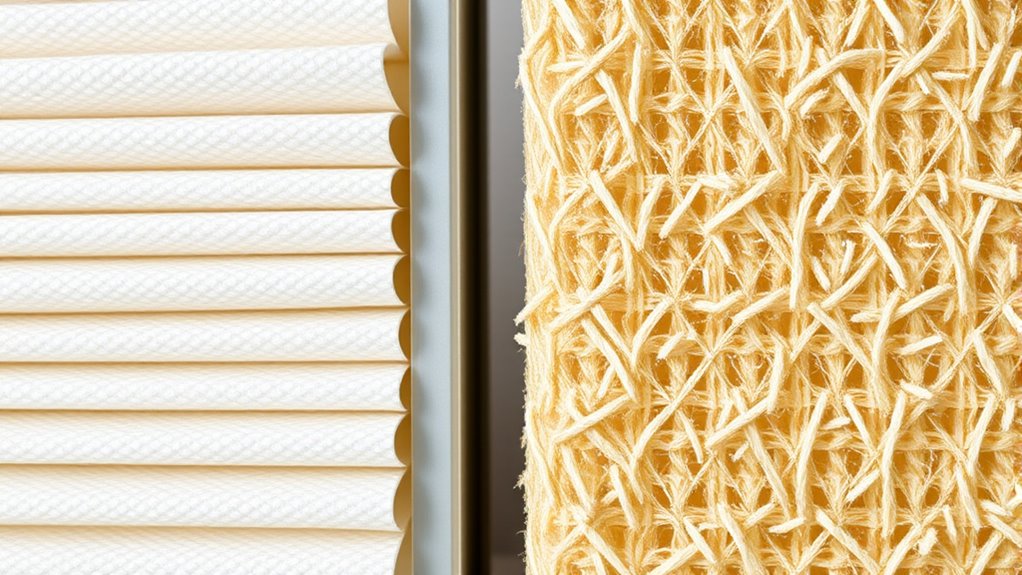
When choosing an air filter for your home, understanding the differences between pleated and fiberglass filters is essential. One of the most important factors to contemplate is airflow efficiency. Pleated filters generally provide better airflow because their design allows for a larger surface area, which reduces resistance as air passes through. This means your HVAC system doesn’t have to work as hard, potentially saving energy and prolonging its lifespan. Fiberglass filters, on the other hand, tend to have a more open mesh structure, which may allow for decent airflow but doesn’t match the efficiency of pleated filters. If airflow efficiency is a priority — especially in homes with high ceilings or large spaces — pleated filters are usually the better choice.
Maintenance requirements also play a significant role in deciding which filter suits your needs. Pleated filters typically have a higher MERV (Minimum Efficiency Reporting Value) rating, meaning they capture more airborne particles, including dust, pollen, and pet dander. Because they trap more debris, they tend to need replacing more frequently, often every 1 to 3 months depending on usage and indoor air quality. While this might seem like a downside, the increased filtration can improve overall indoor air quality, especially for allergy sufferers. Fiberglass filters are less efficient at trapping small particles, but they are also cheaper and tend to last longer — usually around 1 to 3 months as well, but with less maintenance required due to their lower filtration capacity.
If you’re looking for a filter that’s low-maintenance and budget-friendly, fiberglass could be suitable, especially in areas where air quality isn’t a major concern. However, if you want a more thorough filtration and are willing to replace your filter more often, pleated filters are advantageous. They also tend to be more durable structurally, resisting tears and damage during handling. Keep in mind that the higher efficiency of pleated filters can sometimes cause a slight decrease in airflow if your HVAC system isn’t designed for high-MERV filters, so it’s essential to balance airflow efficiency with filtration needs. Additionally, staying informed about AI vulnerabilities and ensuring your HVAC system is properly maintained can prevent potential issues with filter performance. Ultimately, your choice depends on your specific environment, health considerations, and willingness to perform regular maintenance. Both filters have their place, but understanding these key differences helps you make an informed decision to keep your home comfortable and your HVAC system running smoothly.
Frequently Asked Questions
How Do Pleated and Fiberglass Filters Compare in Cost?
You’ll find that fiberglass filters are generally cheaper, making them a budget-friendly choice for basic filtration. Pleated filters tend to cost more upfront because they offer better air quality and durability. The price differences reflect their performance; while fiberglass filters are affordable, pleated filters cost more but last longer and trap more particles. Your decision depends on balancing initial cost with long-term benefits and air quality needs.
Which Filter Type Is More Environmentally Friendly?
Ever wondered which filter is greener? Fiberglass filters tend to be more environmentally friendly because of their recyclability considerations and lower manufacturing environmental impact. They are typically made from recycled glass and are more biodegradable than pleated filters, which often contain synthetic materials. Choosing fiberglass filters reduces waste and energy consumption during production, making them a better choice if you’re prioritizing sustainability in your HVAC system.
How Often Should Each Filter Type Be Replaced?
You should replace fiberglass filters every 30 days to maintain ideal filter lifespan and air quality. Pleated filters typically need replacement every 90 days, depending on usage and indoor conditions. Regular replacement ensures your HVAC system runs efficiently and prolongs filter effectiveness. Keep an eye on signs of dirt buildup or reduced airflow, and adjust your replacement frequency accordingly for the best indoor air environment.
Can Both Filters Be Used in the Same HVAC System?
Yes, you can use both filters in the same HVAC system, but you need to consider filter compatibility and installation considerations. Make sure the filter sizes match your system’s specifications and that the filter type is appropriate for the airflow and filtration needs. Switching between pleated and fiberglass filters should be done carefully, ensuring they fit securely and won’t restrict airflow, to maintain ideal system performance.
Do Filter Materials Affect Indoor Allergen Levels Differently?
You might notice different impacts on airborne allergen removal based on filter material. Fiberglass filters generally trap larger particles but are less effective for fine allergens, while pleated filters excel at capturing smaller airborne allergens due to their increased surface area. The filter material’s effectiveness directly influences indoor allergen levels, so choosing the right filter can make a significant difference in improving your home’s air quality and reducing allergy symptoms.
Conclusion
So, after all that, it’s funny how the most affordable filters often do the least. You might think fiberglass saves you money, but in the long run, you’ll spend more on replacements and air quality issues. Meanwhile, those fancy pleated filters seem pricey upfront, but they actually keep your air cleaner and your HVAC happier. Turns out, choosing the cheapest option might just be the most expensive mistake—who knew?
